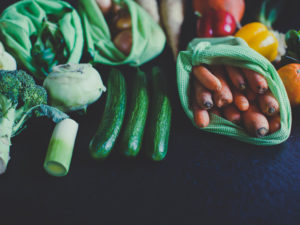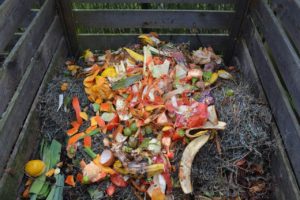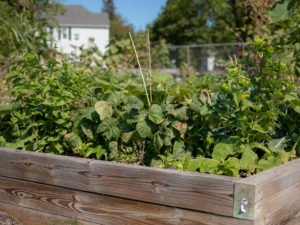Change What You Eat
Food and agricultural production accounts for nearly a quarter of our greenhouse gas emissions. By shifting our diets, we can reduce the amount of food that needs to be grown and its related greenhouse gas emissions. The good news is that there are easy ways to reduce your food’s carbon footprint. These include replacing meat with a vegetarian meal once a week, buying sustainably farmed products, limiting the amount of food packaged in plastic, or cutting out meat and dairy.
Eat vegetarian once a week to reduce red meat consumption. According to the USDA, in 2018 Americans ate 222.2 pounds of red meat and poultry, up from 216.9 pounds per person in 2017. That is 9.6 ounces of meat a day—nearly double the USDA recommended daily consumption of 5.5 ounces of lean meat. Livestock agriculture, specifically beef, produces methane and nitrous oxide. Methane and nitrous oxide are also released from manure and wastes on pastures left from ruminant animals (those with a four-compartment stomach like cattle), and from fertilizers used on cattle feed crops. By reducing our consumption of red meat, your health and the planet’s health may improve.
Buy sustainably farmed products and learn how your food is farmed. Different farming practices lead to different emissions. For example, paddy rice is a crop that historically has consumed disproportionate amounts of water for growth and uses excessive pesticides, leading to a higher environmental footprint. There are different types of rice farming methods, and many rice-growing regions are trying to adopt better practices and reclaimed or recycled water, and other practices that reduce greenhouse gas emissions. Look for sustainable farming practices mentioned on your favorite foods next time you go to the grocery store.
Buy food in recyclable containers. One way to reduce your footprint is to simply reduce the amount of packaging you buy. Instead of buying pre-packaged vegetables, buy fresh ones and use a recyclable produce bag. For products that must come in prepackaged containers, like milk, look for recyclable containers. While milk, like meat, has a high impact on GHG and water consumption, if you buy your milk from a local farm that uses recyclable packaging, you will reduce your reliance on plastic milk containers and cut transportation emissions.
Cut meat and dairy products from your diet. More than half of food emissions come raising livestock. Cutting the food produced from them, meat and dairy, from your diet can cut your personal carbon footprint by two-thirds.
Find out what your food’s carbon footprint is with the Climate Change Food Calculator. This tool provides a baseline to understanding the carbon footprint of different foods, and for some of the food choices the amount of water is also presented which gives a more complete picture for making climate-friendly food choices.
Did you take this action? Report it!
Help us show our collective community impact by reporting that you took this action.



